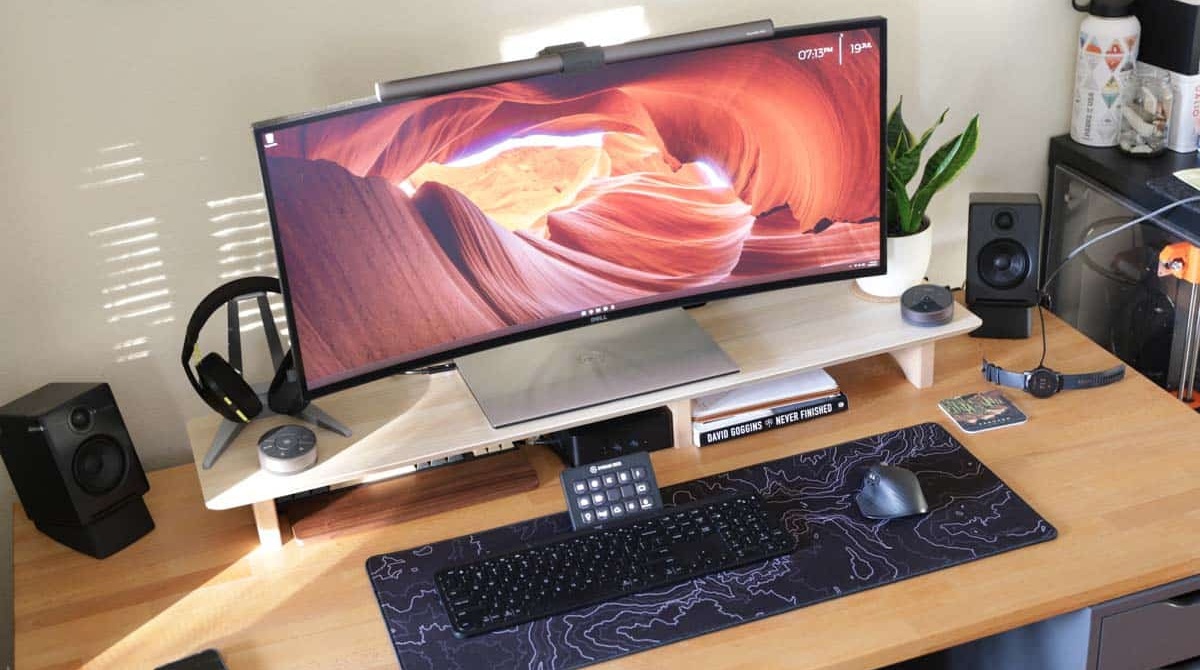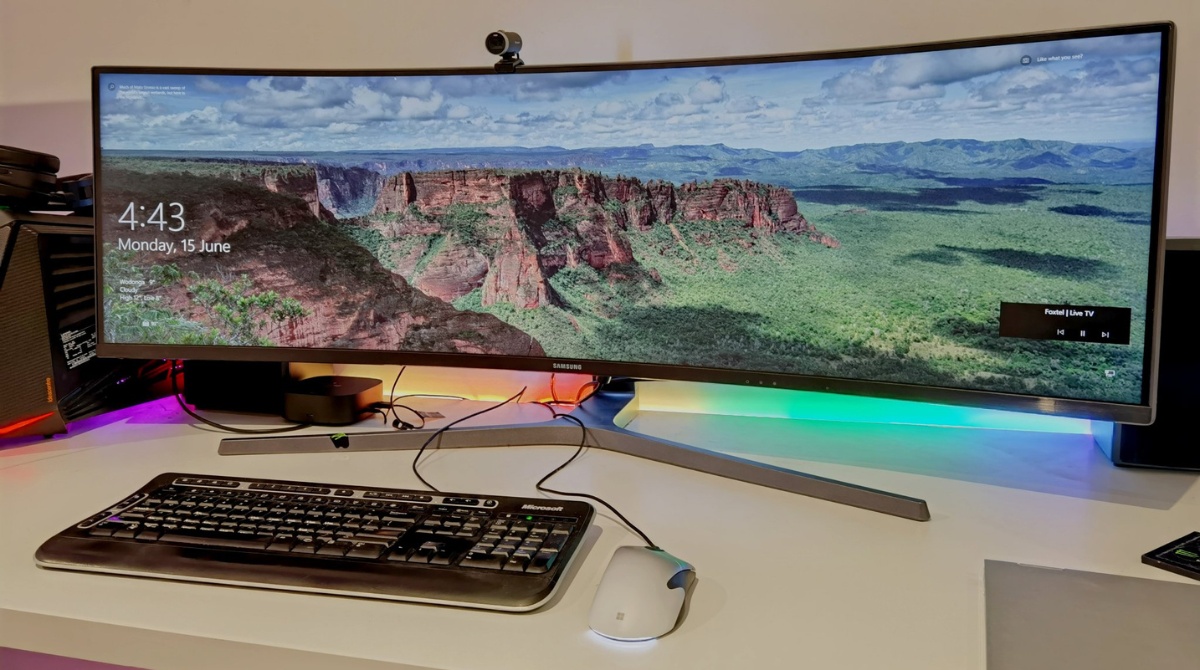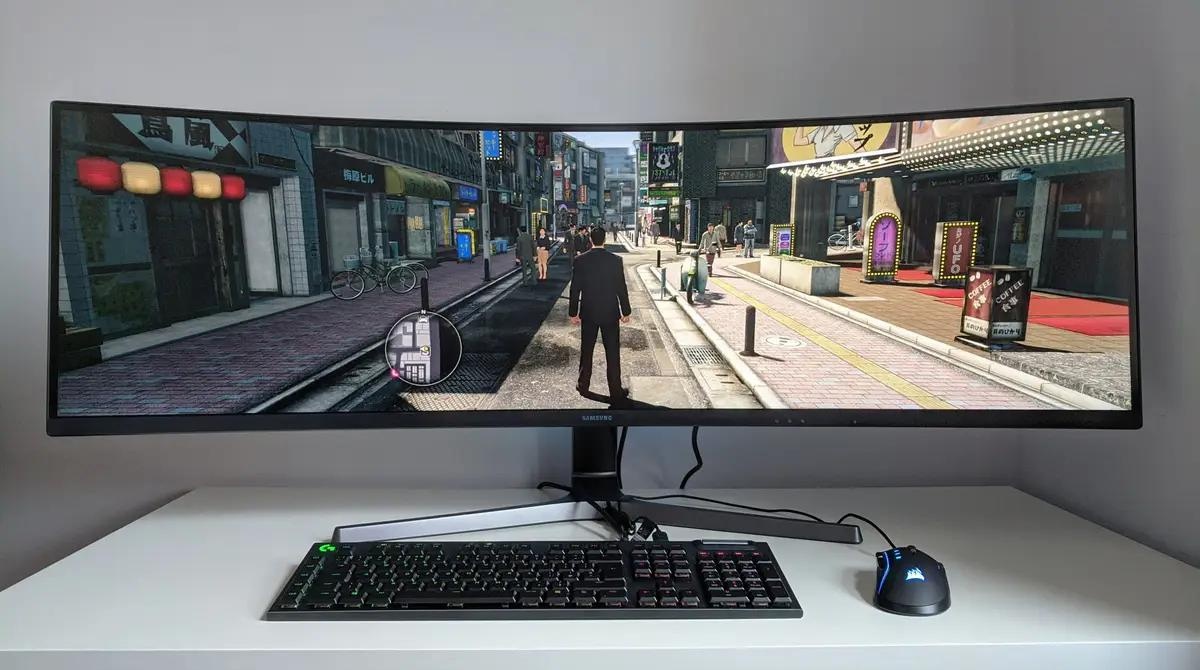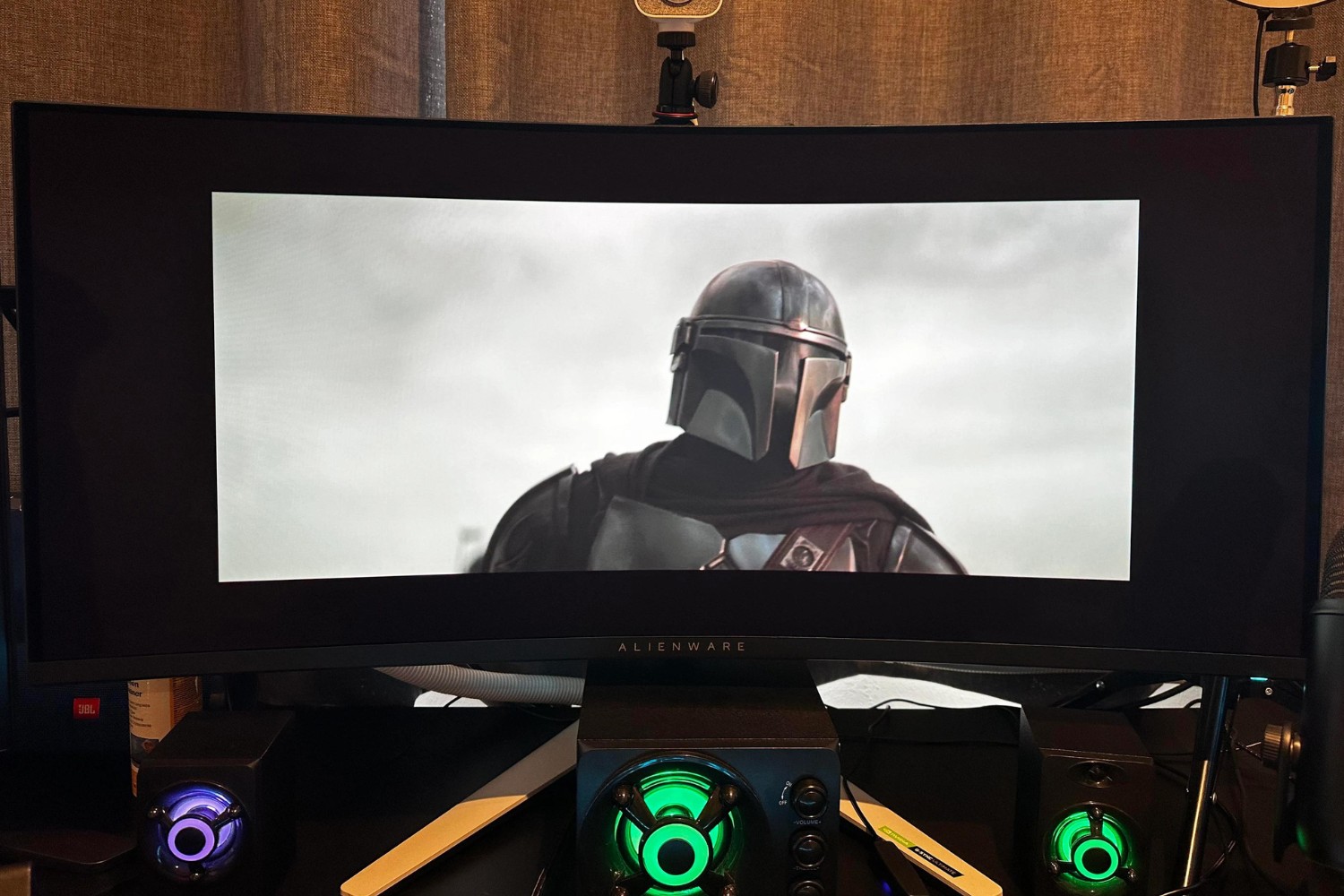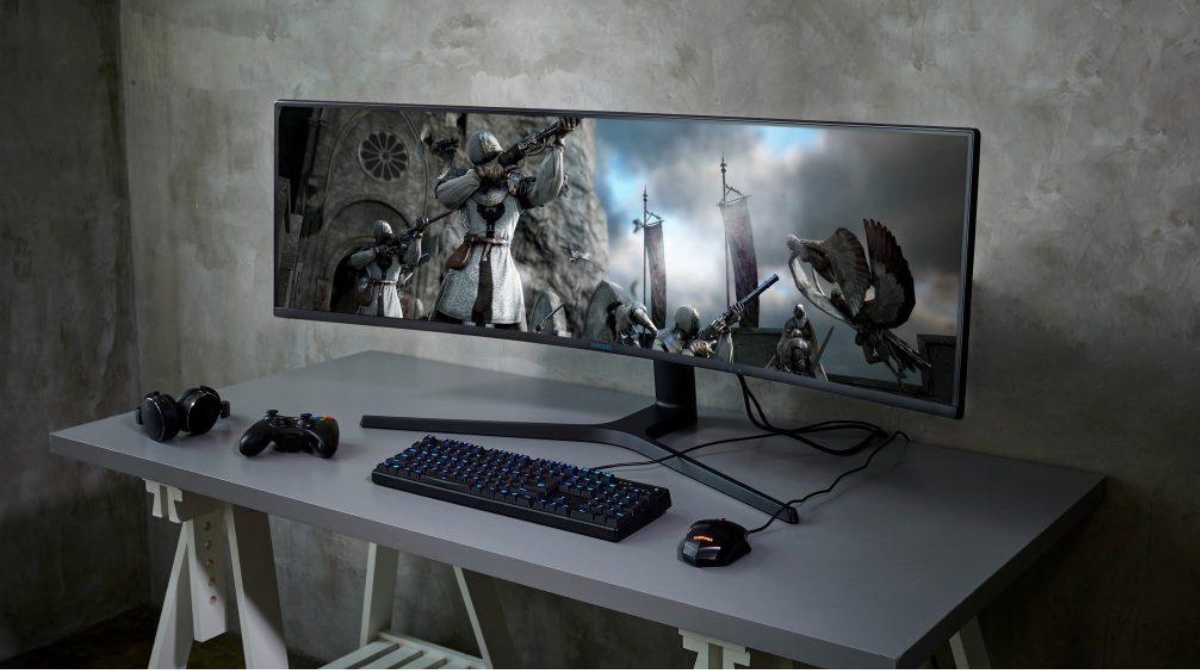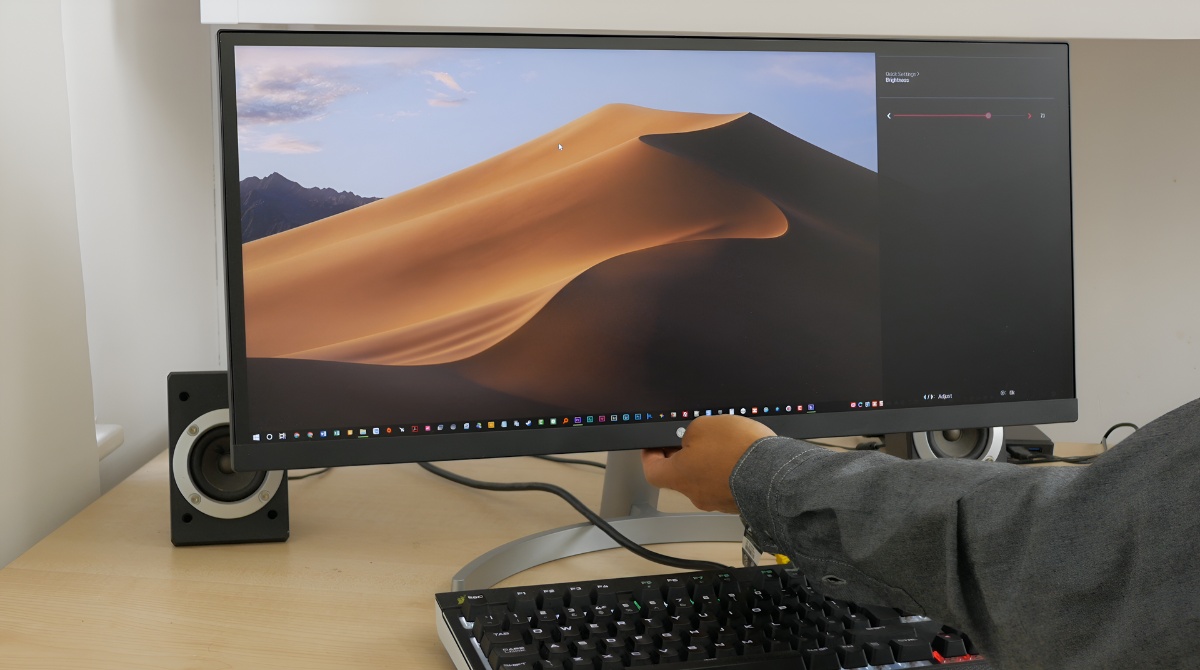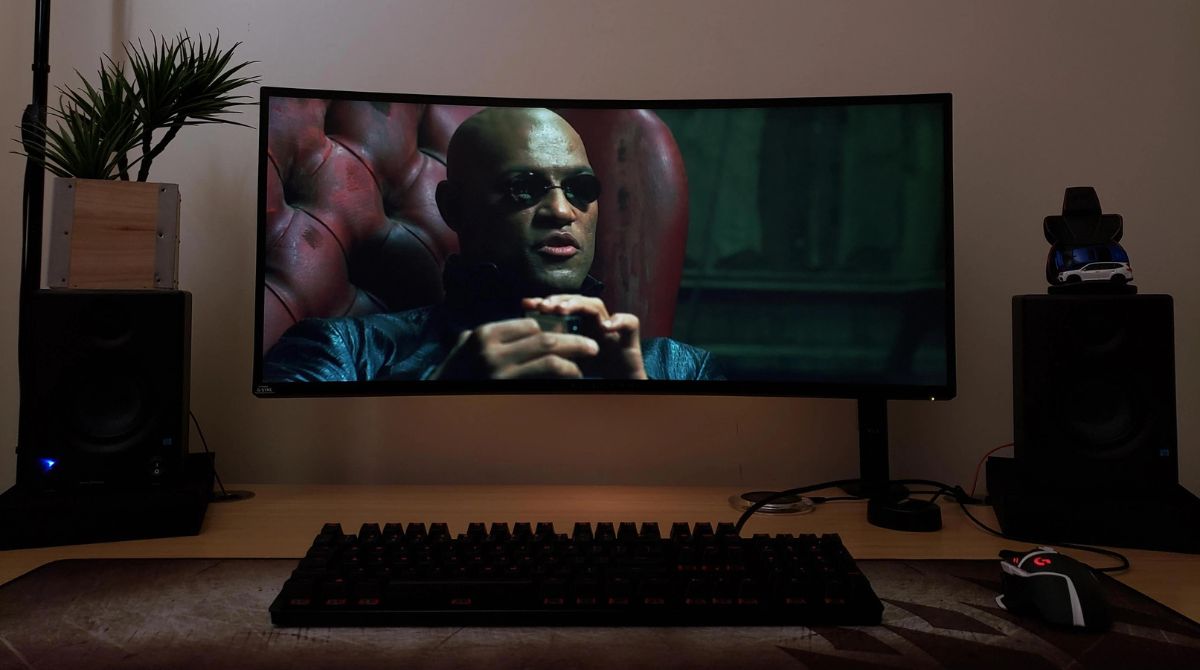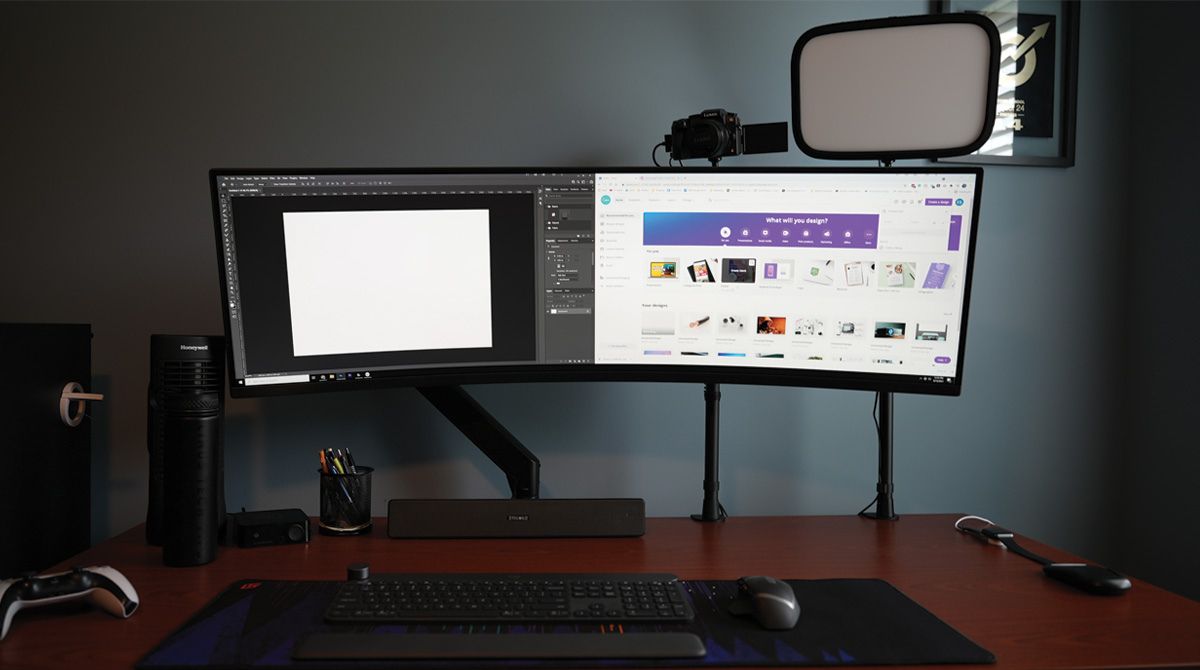Introduction
Welcome to the world of ultrawide monitors, where your computing experience expands beyond the boundaries of a traditional screen. An ultrawide monitor provides a wider and more immersive display, allowing you to see more content and enjoy a more encompassing visual experience. Whether you’re a graphics designer, a gamer, or a professional multitasker, an ultrawide monitor can revolutionize the way you work and play.
In this article, we will guide you through the process of setting up your ultrawide monitor. From choosing the right monitor for your needs to enhancing productivity and optimizing gaming experiences, we’ll cover all the essential steps to ensure you make the most of your display.
But first, let’s explore why an ultrawide monitor might be the right choice for you. Traditional monitors typically have an aspect ratio of 16:9, which means they are wider than they are tall. While they are suitable for most tasks, they can often feel cramped when working on multiple windows or editing large images or videos. This is where ultrawide monitors shine. With an aspect ratio of 21:9 or even 32:9, ultrawide monitors offer significantly more horizontal screen real estate, allowing you to comfortably view multiple applications side by side or indulge in a truly immersive gaming experience.
Ultrawide monitors also offer enhanced productivity by reducing the need for multiple monitors, which can clutter your workspace and introduce cable management challenges. Instead of alt-tabbing between different applications or constantly rearranging windows, an ultrawide monitor lets you view all your programs at once, making multitasking effortless.
Moreover, these monitors are becoming increasingly popular among gamers. The wider field of view can provide a competitive advantage in gaming, allowing you to spot enemies or details that could be easily missed on a narrower display. Additionally, many ultrawide monitors offer features like higher refresh rates and adaptive sync technologies, providing a smoother and more immersive gaming experience.
So, whether you’re a professional looking to boost productivity, a creative seeking a better view of your artwork, or a gamer wanting a competitive edge, setting up an ultrawide monitor can elevate your computing experience to new heights. Let’s dive into the details and discover how to set up your ultrawide monitor for optimal performance and enjoyment.
Choosing the Right Ultrawide Monitor
Before diving into the setup process, it’s important to choose the right ultrawide monitor that suits your needs and preferences. With a wide range of options available, it can be overwhelming to make the right decision. Here are some key factors to consider when selecting the perfect ultrawide monitor:
- Screen Size: Ultrawide monitors come in various sizes, typically ranging from 29 inches to 49 inches. Consider the size of your desk and the distance at which you’ll be sitting to determine the optimal screen size for your setup.
- Resolution: The resolution of the monitor determines the level of detail and clarity it can display. Higher resolutions like WQHD (2560×1440) or Ultra HD (3840×2160) offer a sharper image, but keep in mind that your computer’s graphics card needs to be capable of powering such a high resolution.
- Aspect Ratio: Ultrawide monitors typically have an aspect ratio of 21:9 or 32:9. Consider your primary use cases for the monitor, whether it’s work-related tasks, gaming, or entertainment, and choose an aspect ratio that suits your needs.
- Curved or Flat: Many ultrawide monitors come in a curved design, which enhances the viewing experience by providing a more immersive feel and reducing eye strain. However, if you prefer a flat display or plan to do precise design work, a flat ultrawide monitor might be a better option.
- Connectivity: Ensure that the ultrawide monitor has the necessary ports to connect to your computer, such as HDMI, DisplayPort, or USB ports. Additionally, check if it supports any specific connectivity features you may require, such as Thunderbolt or USB-C.
- Extra Features: Consider any additional features that might enhance your experience, such as built-in speakers, adjustable stands, or compatibility with HDR (High Dynamic Range) content.
Take the time to research and read reviews to find the best ultrawide monitor that fits your budget and requirements. Keep in mind that your monitor is a long-term investment, so it’s worth considering future-proof features and ensuring compatibility with your existing hardware.
Once you have chosen the right ultrawide monitor, you’re ready to move on to setting it up and unlocking its full potential. In the next section, we’ll guide you through the unboxing and initial setup process, so you can start enjoying your new ultrawide display.
Unboxing and Setting Up the Monitor
Now that you’ve chosen the perfect ultrawide monitor, it’s time to unbox it and get it set up for use. Follow these steps to ensure a smooth and hassle-free setup process:
- Prepare your workspace: Clear off your desk or workspace to make room for the new monitor. Remove any obstacles and ensure that you have sufficient space to comfortably position the monitor.
- Unboxing: Carefully unbox the monitor, being cautious not to damage any parts. Remove all the protective packaging materials and locate the included accessories, such as the stand, cables, and power adapter.
- Assembly: If the monitor requires assembly, carefully follow the instructions provided. Attach the stand or mount the monitor according to the manufacturer’s guidelines.
- Positioning: Decide on the ideal placement of the monitor on your desk. Consider factors such as viewing distance, ergonomics, and minimizing glare from external light sources.
- Power: Connect the monitor to a power outlet using the provided power cable. Ensure that the power source is stable and grounded.
- Connectivity: Depending on the available ports on your monitor and computer, choose the appropriate cable (HDMI, DisplayPort, or USB) to connect the monitor to your computer. Connect one end of the selected cable to the monitor and the other end to the corresponding port on your computer.
- Power On: Press the power button on the monitor to turn it on. You should see the monitor display come to life.
- Adjustments: Make any necessary adjustments to the monitor settings, such as brightness, contrast, and color temperature, to suit your preferences.
- Software Installation: Some monitors may require you to install specific software or drivers to access all the features. Check the manufacturer’s website or included documentation for any necessary software installations.
- Test and Troubleshoot: Verify that the monitor is functioning correctly by testing various applications, videos, and games. If you encounter any issues, consult the user manual or the manufacturer’s support resources for troubleshooting guidance.
By following these steps, you’ll have your new ultrawide monitor unboxed, assembled, and connected to your computer in no time. Once the setup is complete, you’re ready to move on to the next step – adjusting the display settings to maximize your viewing experience. We’ll cover this in the next section.
Connecting the Monitor to your Computer
Now that your ultrawide monitor is unboxed and set up, it’s time to connect it to your computer. Follow these steps to establish the connection:
- Identify available ports: Examine the back of your computer and locate the available video output ports. These ports may include HDMI, DisplayPort, DVI, or VGA. Refer to your computer’s manual or specifications to determine which ports are compatible with your ultrawide monitor.
- Choose the appropriate cable: Based on the available ports on your computer and monitor, select the appropriate cable for the connection. HDMI and DisplayPort cables are commonly used for ultrawide monitors due to their ability to transmit high-quality audio and video signals.
- Connect the cable: Connect one end of the cable to the corresponding video output port on your computer and the other end to the corresponding input port on your monitor. Ensure the connections are secure.
- Power on your monitor: Turn on your ultrawide monitor by pressing the power button. The monitor should detect the connection and display an image from your computer.
- Configure display settings: Depending on your operating system, you may need to adjust the display settings to optimize the output on your ultrawide monitor. Right-click on your desktop and select “Display settings” or access the display settings from the Control Panel/System Preferences. Here, you can adjust the resolution, aspect ratio, and arrange multiple displays if necessary.
- Extend or duplicate display: Determine whether you want to extend your desktop across both your ultrawide monitor and your computer’s built-in display or duplicate the display on both screens. This can be set up in the display settings mentioned in the previous step.
- Calibrate colors: To ensure accurate colors and optimal viewing experience, you may want to calibrate your ultrawide monitor. This can be done using built-in calibration tools in your operating system or using specialized hardware calibration tools.
- Audio connection (optional): If your ultrawide monitor has built-in speakers or you want to use external speakers connected to the monitor, ensure the audio cable is properly connected to the audio input/output ports on your computer and monitor.
Once you’ve successfully connected your ultrawide monitor to your computer and configured the display settings, you’re ready to enjoy your expansive and immersive workspace. In the next section, we’ll explore the importance of adjusting display settings for optimal performance.
Adjusting Display Settings
After connecting your ultrawide monitor to your computer, it’s crucial to adjust the display settings to optimize the visual experience. Here are some key settings you should consider adjusting:
- Resolution: Set the resolution to the native resolution of your ultrawide monitor. This ensures that the content is displayed at the optimal level of detail and clarity.
- Aspect ratio: Confirm that the aspect ratio is correctly set to match the specifications of your ultrawide monitor. Most ultrawide monitors have an aspect ratio of 21:9 or 32:9.
- Brightness and contrast: Adjust the brightness and contrast levels to your preferred settings. Avoid setting the brightness too high, as it can cause eye strain and fatigue.
- Color temperature and calibration: Adjust the color temperature to achieve accurate and pleasing colors on your ultrawide monitor. You can also consider using color calibration tools to fine-tune the color accuracy.
- Refresh rate: If your ultrawide monitor supports a higher refresh rate, such as 144Hz or 240Hz, ensure that it is set to its maximum value. This improves the smoothness of motion in videos and games.
- Gamma correction: Adjust the gamma setting to achieve optimal brightness and contrast levels across different shades of gray. This helps to enhance the overall picture quality.
- Overdrive: Some ultrawide monitors feature an overdrive setting that helps to reduce ghosting and motion blur in fast-paced games or videos. Experiment with different levels to find the optimal setting for your preferences.
- Aspect ratio scaling: Depending on the content you are viewing, you may need to adjust the aspect ratio scaling. This ensures that images and videos are not distorted or stretched and appear correctly on the ultrawide screen.
- Gaming-specific settings: If you are a gamer, explore the gaming-specific settings offered by your ultrawide monitor. These may include features like adaptive sync, game mode presets, and crosshair overlays to enhance your gaming experience.
Take your time to experiment with these display settings and fine-tune them according to your preferences. Remember that personal preferences can vary, so adjust the settings that provide the best visual experience for your specific needs and activities.
Once you’ve adjusted the display settings, you’re all set to enjoy the immersive and visually stunning experience that your ultrawide monitor has to offer. In the next section, we’ll delve into calibrating the color accuracy of your monitor for professional or color-sensitive work.
Calibrating Color Accuracy
Calibrating the color accuracy of your ultrawide monitor is essential for tasks that require precise and consistent colors, such as graphic design, photo editing, or video production. Here are the steps to calibrate the color accuracy:
- Hardware Calibration: Consider using a hardware calibration device, such as a colorimeter or spectrophotometer, for precise and accurate results. These devices measure and adjust the colors directly on the monitor.
- Software Calibration: If a hardware calibration device is not available, you can use built-in calibration tools in your operating system or dedicated calibration software. These tools provide step-by-step instructions to adjust the colors manually.
- Color Space and Gamma: Choose the appropriate color space and gamma settings based on your workflow requirements. Common options include sRGB, Adobe RGB, and DCI-P3. Select the color space that best suits your intended output, such as web or print.
- White Point: Adjust the white point, which refers to the color temperature of the monitor’s white. The most common white point is D65, which represents daylight. However, you may need to adjust it depending on your specific environment and lighting conditions.
- Black Level: Set the black level to ensure that the dark areas of your content retain detail and do not appear washed out. Adjust it carefully to maintain contrast without losing any shadow information.
- Gamma Correction: Calibrate the gamma settings to achieve better tonal representation and contrast across different shades. The gamma settings impact how the monitor displays midtones and shadows.
- Color Accuracy Confirmation: After calibrating the color settings, verify the results by comparing the on-screen colors to known color references, color charts, or printed output. These visual checks help ensure that the monitor is displaying colors accurately.
Remember, color calibration is an ongoing process, as the monitor’s color accuracy may drift over time due to factors like aging or changes in ambient lighting conditions. It’s recommended to recalibrate your monitor periodically to maintain accurate and consistent colors.
By calibrating the color accuracy of your ultrawide monitor, you can have confidence in the color reproduction and ensure that your creative work accurately reflects your intended vision. In the next section, we’ll explore how to make ergonomic adjustments for comfortable viewing.
Adjusting Ergonomics for Comfortable Viewing
Setting up your ultrawide monitor with proper ergonomics is crucial to maintain a comfortable and healthy viewing experience. Here are some key adjustments you can make to ensure ergonomic correctness:
- Monitor Height: Position the monitor at eye level or slightly below. This helps prevent neck strain and promotes a more natural and comfortable viewing angle.
- Distance: Sit at a comfortable distance from the monitor, typically around arm’s length or slightly further. Avoid sitting too close, as it can result in eye strain and fatigue.
- Tilt Adjustment: Tilt the monitor to find the optimal angle for your viewing comfort. Most monitors offer a range of tilt adjustments to accommodate various preferences.
- Swivel and Pivot: If your ultrawide monitor offers swivel or pivot functions, adjust them accordingly to accommodate different viewing needs, such as sharing the screen with others or switching between portrait and landscape orientations.
- Reducing Glare: Position the monitor to minimize glare from external light sources. Adjust the angle of the monitor or use curtains or blinds to control the amount of light entering the room.
- Use a Monitor Stand or Mount: Consider using a monitor stand or mount to raise the monitor to the desired height and free up desk space. This can help achieve a more ergonomic and clutter-free workstation.
- Keyboard and Mouse Placement: Keep your keyboard and mouse at a comfortable height and distance from the monitor. Maintain a relaxed and natural arm and wrist position to prevent strain or discomfort.
- Take Frequent Breaks: Remember to take regular breaks and engage in short stretching exercises or eye relaxation techniques to reduce fatigue and promote overall well-being.
Proper ergonomics ensure that you can work or enjoy entertainment on your ultrawide monitor without experiencing discomfort or long-term health issues. By making these adjustments, you’ll create a more ergonomic and user-friendly workspace for prolonged and comfortable use of your monitor.
Now that you’ve adjusted the ergonomics of your setup, you can fully immerse yourself in productivity or indulge in a captivating gaming experience. In the next section, we’ll explore how to enhance productivity with split-screen and multitasking features available on ultrawide monitors.
Enhancing Productivity with Split-Screen and Multitasking
An ultrawide monitor offers a wide field of view, making it a powerful tool for enhancing productivity and multitasking. With the ability to display multiple windows side by side, you can accomplish more in less time. Here’s how you can make the most of split-screen and multitasking features:
- Split-screen software: Many operating systems have built-in features to enable split-screen multitasking. Use these options to easily divide the screen into two or more sections, allowing you to work on multiple applications simultaneously.
- Drag and drop: Simply drag and drop windows into different areas of the screen to arrange them according to your workflow. For example, you can have a web browser open on one side while working on a document or spreadsheet on the other.
- Virtual desktops: Take advantage of virtual desktops to create separate workspaces dedicated to different tasks or projects. This allows you to switch between different sets of applications without cluttering your main desktop.
- Taskbars and shortcuts: Make use of taskbars and shortcuts to easily switch between applications or switch focus to different windows within the same application. This streamlines navigation and improves overall efficiency.
- Positional awareness: Leverage the wider screen real estate to gain positional awareness and keep important tools or documents visible at all times. For example, you can have a reference document or a chat application always visible while working on your main task.
- Collaboration and presentations: During collaborative sessions or presentations, use split-screen to display multiple content sources simultaneously. This enables seamless sharing of information and enhances communication and collaboration.
- Window management tools: Consider using window management tools or extensions that provide additional functionality for organizing and arranging windows on your ultrawide monitor. These tools can automate window resizing, snapping, and positioning.
- Customize your workflow: Experiment with different arrangements and combinations that suit your specific workflow and preferences. Fine-tune your multitasking setup to maximize productivity and minimize distractions.
By effectively utilizing split-screen and multitasking features, you can optimize your workflow, save time, and accomplish more in a single glance. An ultrawide monitor’s expansive workspace empowers you to work on multiple tasks simultaneously without the need for multiple monitors or constant window switching.
Now that you’ve mastered the art of split-screen multitasking, let’s delve into how you can optimize your gaming experience on an ultrawide monitor in the next section.
Optimizing Gaming Experience on an Ultrawide Monitor
Ultrawide monitors offer gamers an immersive and captivating gaming experience. The wider field of view, enhanced detail, and seamless visuals can take your gaming adventures to the next level. Here are some tips to optimize your gaming experience on an ultrawide monitor:
- Resolution and Refresh Rate: Set your game’s resolution to match the native resolution of your ultrawide monitor for the best visual fidelity. Additionally, consider adjusting the refresh rate to its maximum capacity to ensure smooth, fluid gameplay.
- Field of View (FOV): Take advantage of the wider field of view on your ultrawide monitor by increasing the FOV setting in games that support it. This provides a broader perspective and allows you to see more of the game world.
- Graphics Settings: Adjust the graphics settings in games to strike the right balance between visual quality and performance. Experiment with settings like anti-aliasing, texture quality, and shadows to find the optimal configuration for your system.
- Ultrawide Support: Look for games that have native ultrawide support or mods available that provide ultrawide compatibility. This ensures that the game fills the entire screen without any stretching or letterboxing.
- Adaptive Sync: If your ultrawide monitor supports technologies like G-Sync or FreeSync, enable them to prevent screen tearing and ensure smooth gameplay, especially during fast-paced action sequences.
- Game-specific Settings: Explore the individual settings available within each game. Some games may offer additional features like ultrawide-specific UI elements, customizable crosshairs, or game mode presets to further enhance your gaming experience.
- Multiplayer Advantage: The wider field of view offered by an ultrawide monitor can provide a competitive edge in multiplayer games. Utilize your expanded peripheral vision to spot enemies or important details that might be missed on narrower displays.
- Immersive Sound: Pair your ultrawide monitor with high-quality headphones or speakers to create an immersive gaming environment. Crystal-clear audio enhances the overall experience and adds another layer of immersion to your gaming sessions.
- Community and Online Resources: Join gaming communities or forums dedicated to ultrawide gaming to discover tips, tricks, and optimized settings for specific games. Benefit from the experience and knowledge of other gamers to optimize your gaming experience.
With careful adjustments and optimizations, playing games on an ultrawide monitor can elevate the visual experience, enhance gameplay immersion, and provide a competitive edge. Immerse yourself in rich landscapes, expansive environments, and intense action on your ultrawide monitor.
Now that you’re armed with the knowledge to optimize your gaming experience, in the next section, we’ll explore some common issues that you may encounter with your ultrawide monitor and provide troubleshooting tips.
Troubleshooting Common Issues
While ultrawide monitors offer an exceptional viewing experience, you may occasionally encounter some common issues. Here are troubleshooting tips for addressing these issues:
- Aspect Ratio Issues: If you notice stretched or distorted content, ensure that the aspect ratio setting on your monitor matches the output signal from your computer. Adjust the aspect ratio in the monitor settings or graphics card control panel if necessary.
- Resolution Mismatch: If the resolution of your monitor does not match the supported resolution in your computer’s display settings, update your graphics card drivers. This ensures proper communication between the computer and the monitor.
- Flickering or Screen Tearing: Enable adaptive sync technologies, such as G-Sync or FreeSync, if your monitor supports them. Alternatively, adjust the refresh rate or enable V-Sync in game settings to reduce screen tearing and flickering.
- Black Bars: If you see black bars on the sides or top and bottom of the screen, it indicates that the content does not support the ultrawide aspect ratio. You can use software or mods to force the content to fill the entire screen or play games that have native ultrawide support.
- Incompatible Applications: Some older applications may not be optimized for ultrawide displays, resulting in text or UI elements appearing too small or stretched. Look for compatibility options or alternative applications that support a wider aspect ratio.
- Color Inconsistencies: If you notice color inconsistencies between your ultrawide monitor and other displays, check the color profile settings in your operating system. Ensure that each display is using the correct color profile for accurate color representation.
- Connectivity Issues: If you’re experiencing connectivity problems, check the cables and connections. Sometimes, a loose or faulty cable can cause intermittent or no signal issues. Try using different cables or ports to determine if the problem is related to the connections.
- External Device Compatibility: Ensure that any external devices you connect to your ultrawide monitor, such as gaming consoles or media players, support the ultrawide aspect ratio. Some devices may have limited or no support for ultrawide resolutions.
- Driver and Firmware Updates: Periodically check for driver and firmware updates for your monitor and graphics card. Manufacturers often release updates to address compatibility issues, improve performance, and add new features. Keeping your software up to date can resolve many common issues.
Remember, if you encounter persistent issues with your ultrawide monitor that you cannot resolve, consult the user manual or contact the manufacturer’s support for further assistance. Their technical experts can provide specific guidance tailored to your monitor model.
Now that you’re equipped with troubleshooting tips, you can quickly overcome any hurdles and enjoy a seamless experience with your ultrawide monitor. In the concluding section, we’ll recap the key points covered in this guide on setting up an ultrawide monitor.
Conclusion
Setting up an ultrawide monitor can transform your computing and gaming experience, offering a more immersive and productive workspace. By following the steps outlined in this guide, you can maximize the potential of your ultrawide monitor and enjoy its benefits to the fullest.
From choosing the right monitor to unboxing, connecting, and adjusting settings, we explored every aspect of the setup process. We learned how to enhance the visual experience by calibrating color accuracy, optimizing display settings, and adjusting ergonomics for comfortable viewing.
We also explored how ultrawide monitors excel in multitasking and productivity, empowering users to work with split-screen features and capitalize on the wider field of view. Additionally, we delved into the world of gaming and discovered how to optimize the gaming experience on an ultrawide monitor through resolution, graphics settings, and other gaming-specific tweaks.
Moreover, we tackled common issues that may arise and provided troubleshooting tips to overcome them. Remember to keep your drivers and firmware up to date, and seek support from the manufacturer when needed.
By mastering the setup and configuration of your ultrawide monitor, you can now harness its power to elevate your work, creative projects, and gaming sessions. Enjoy the captivating visuals, expanded workspace, and immersive experiences that an ultrawide monitor brings.
Continue to explore and experiment, making adjustments based on your preferences and needs, and don’t hesitate to share your knowledge and experiences with others in the ultrawide community. With your newfound expertise, you can fully embrace the possibilities of an ultrawide monitor and make the most of this valuable tool in your daily routine.







